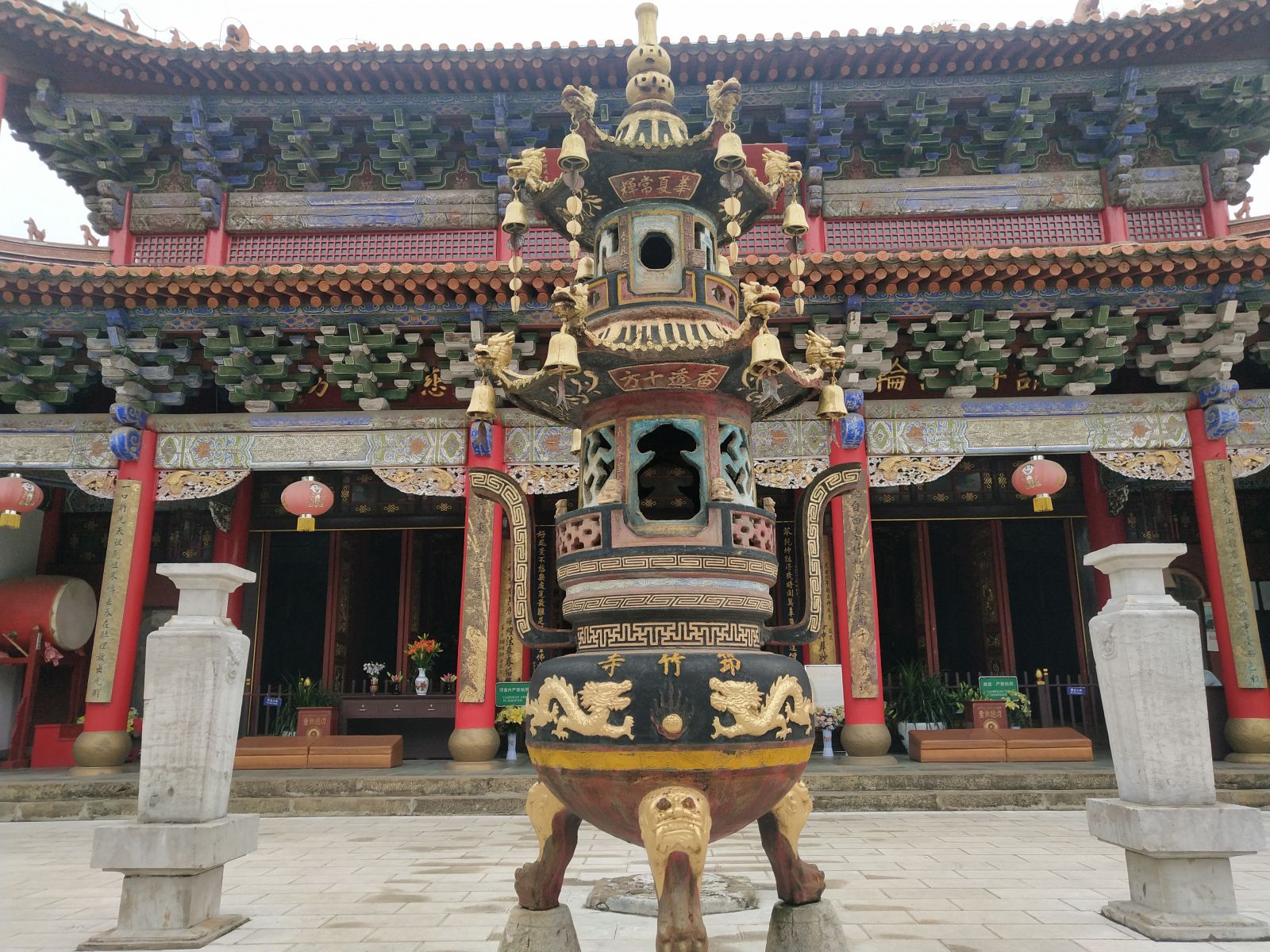Chinese Name: 筇竹寺 Pronunciation: Qióng Zhú Sì
Opening Hours: 8:30-17:00
Best Visiting Season: All seasons
Admission Ticket Fare: 6 yuan
Recommended Time for Visit: 1-2 Hours
Popular Activities: Holding Buddhist ceremonies
Building Function: Introducing Zen Buddhism
Building Time: In the Tang and Song Dynasties (618-1279)
Address: Heiqiong Road, Wuhua District, Kunming, Yunnan Province

The Qiongzhu Temple, located on Yu’an Mountain in the western suburb of Kunming, Yunnan Province, is 12 kilometers away from the center of Kunming. The temple was built between the Tang and Song Dynasties and was rebuilt twice in the Qianlong (1736-1796) and Guangxu (1875-1908) years of the Qing Dynasty.
The temple faces the east. The main buildings of the temple were built along the central axis and divided into three courtyards, the gate, the Hall of Sakyamuni and Huayan Pavilion. The temple boasts a collection of cultural relics, including colored sculptures, inscriptions, couplets, and murals. Among them, the Five Hundred Arhat Statues established in the Guangxu period of the Qing Dynasty are well-known both at home and abroad.
It is reputed as a National Key Temple and listed in the fifth batch of Major Historical and Cultural Sites protected at the national level.
The Bamboo Temple was built between the Tang and Song Dynasties.
In the beginning, the temple was not valued by people. Then in the Yuan Dynasty, Master Xiongbian preached scriptures here, and it had gained a high reputation.
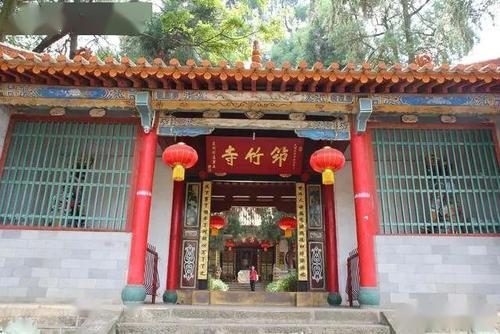
In 1419, the temple was destroyed by fire. In the 20th year (1422) of Emperor Yongle of the Ming Dynasty, the temple was restored, and the project was completed in the 3rd year (1428) of Emperor Xuande of the Ming Dynasty, forming a temple complex with a larger scale than that of the Yuan Dynasty.
In the first year (1662) during the reign of Emperor Kangxi of the Qing Dynasty, the Bamboo Temple was rebuilt. Li Guangzuo, a scholar of the Qing Dynasty, wrote A Record of Rebuilding the Bamboo Temple on Yu’an Mountain. In 1684, Cai Yurong, the governor of Yunnan and Guizhou Provinces, ordered to renovate the temple.
From 1883 to 1890, the abbot Mengfo invited craftsmen to rebuild the gate, the Heavenly King Hall, the Hall of Sakyamuni, and the Huayan Pavilion. Li Guangxiu (named Desheng), a clay sculpture artist, was invited to reshape the Five Hundred Arhat Statues with his disciples at the two sides of the the Hall of Sakyamuni, the Tiantailai Pavilion and the Fanyin Pavilion.
In 1983, the temple was designated by the State Council as a National Key Buddhist Temple in the Han-nationality district.
In April 1984, Huayan Pavilion was destroyed by fire. In October 1989, with the support of the government and Buddhist believers, the Huayan Pavilion was rebuilt with raised funds.
In 1985, the temple was handed over to the Buddhist community for management and use.
From December 25 to 26, 1990, the Abbot’s Ascending Ceremony was held in the temple, and Master Mingdao was honored as the abbot of the temple. It had been the first ascending ceremony in Kunming since the founding of the People’s Republic of China.
In 1992, the restoration project of the temple was carried out.
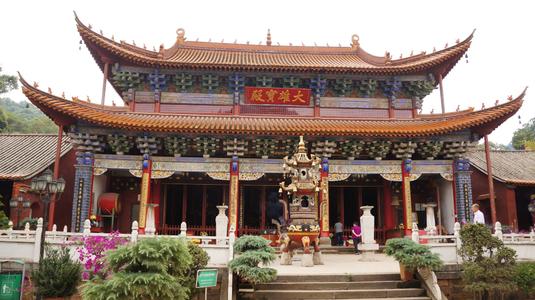
On October 12, 1994, a grand ceremony was held to celebrate the completion of the renovation and the opening ceremony of the statue of Buddha.
In 1996, the local government, in order to develop the economy while protecting the cultural relics, invested a huge amount of money to build the Qiongwang Road from the Bamboo Temple to Wangjiaqiao. It is a “road for trucks” with a special purpose of production and transportation.
On June 25, 2001, as an ancient building of the Qing Dynasty, the temple was announced as a National Key Cultural Relics Protection Unit by the State Council. In the same year, the Cultural Relics Department sent personnel to strengthen monitoring and the Seismological Bureau conducted vibration tests. From September 2001 to February 2002, the Five Hundred Arhat Statues had been repaired by Kunming Municipal Bureau of Religious Affairs.
From July 19 to 25, 2011, in order to pray for the peace of the country and the people and to celebrate the opening ceremony of the Guanyin (Bodhisattva) statue, the abbot and the believers participated in the ceremony in the temple. It is called Shui Lu Rite and is the largest rite of all Buddhist rites.

The Hall of Sakyamuni is located behind the gate and is about 20 meters long and 12 meters wide. The sculptors used the combination of circle shape and group marching arrangement in the design of group sculptures. The Arhat Hall has single carvings and group carvings.
On the corner of the hall is an imperial edict issued in the third year (1316) of Yanyou of the Yuan Dynasty. The content of the imperial edict is to appoint Master Xuanjian as the “head monk”, asking officials, soldiers, and civilians to support him and to keep the Tripitaka Sutra in the temple.
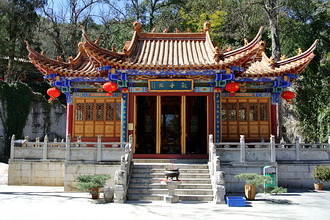
The Huayan Pavilion is about 20 meters long and 10 meters wide. It is the only well-preserved bracket set building of the Qing Dynasty in Kunming. Couplets written by a literati, Qian Nantu of the Qing Dynasty and murals by Li Guangxiu can be seen inside. Unfortunately, it was destroyed by fire in April 1984.
In October 1989, the Bamboo Temple raised funds for its reconstruction and held a grand opening ceremony of the Huayan Pavilion. With a total area of more than 400 square meters, the newly built Huayan Pavilion maintains its original style and feature. There are two floors in the pavilion. In the middle of the first floor, the “Huayan Three Saints” are worshipped, and the jade statue of Sakyamuni, with a height of 2 meters, is worshipped on the second floor.
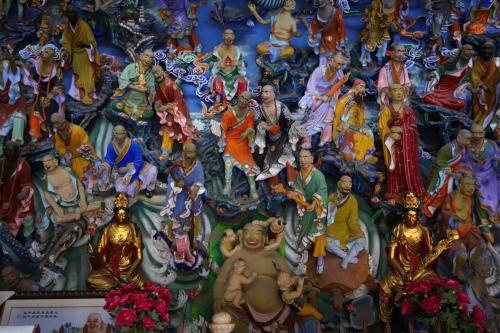
The Five Hundred Arhat Statues in the Bamboo Temple are distributed in the Hall of Sakyamuni(68 statues), the “Tiantailai” Pavilion (216 statues), and the Fanyin Pavilion (216 statues). It took seven years (1883-1890) for Li Guangxiu, a clay sculptor in Sichuan Province of the Qing Dynasty, and his disciples to complete the work.
There are Peacock Daming King Bodhisattva and 58 Arhat statues in the middle hall of “Tiantailai” Pavilion, 75 Arhat statues in the left and right halls respectively, and 10 Arhat statues in the veranda.
Besides, in the middle hall of the Fanyin Pavilion, there are 57 Arhat statues. And there are 75 Arhat statues in the left and right halls respectively and 10 in the veranda.
In the two pavilions, the Arhat statues are divided into three layers, and those at the first and the third layers are in a sitting posture with a height of 1 meter. Those at the second layer is in a standing posture with a height of 1.4 meters.

The characters, vivid and colorful, have different forms of action and expressions, such as happiness, anger, sadness, and joy. Things they hold, such as flowers, sticks, and whips, are mostly made from the materials in the nearby mountains.
With an accurate scale, they focus on the expression of the characters’ bodies, personalities, and changes in their thoughts. They make innovations in the space layout and character modeling. The statues can be comparable to the works of Yang Huizhi, a great sculptor in the Tang Dynasty (618-907).
Compared with Arhat statues in other Buddhist temples of the state, such as the Beijing Biyun Temple, the Wuhan Guiyuan Temple in Hubei Province, and the Changsha Kaifu Temple in Hunan Province, the Five Hundred Arhat statues in the Bamboo Temple have the highest artistic achievements. They are treasures of clay Buddha statues in China and are known as “the Pearl in the Oriental Sculpture Art Treasure Trove”.
“Qiongzhu” , a kind of bamboo named after the ancient city of Qiongdu (today’s Xichang city, Sichuan Province), is a precious bamboo species in China. It is thick and solid and is appropriate to be used as a walking stick.
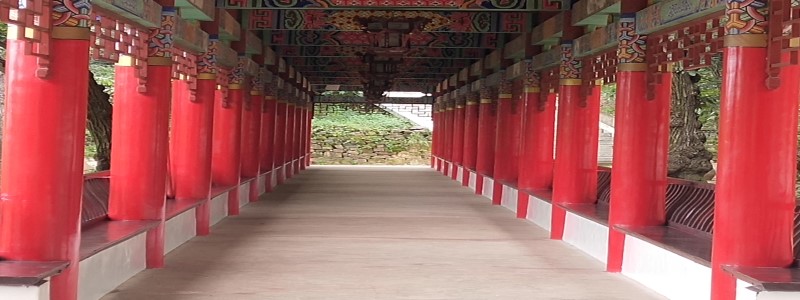
According to historical records, in the Western Han Dynasty (202BC-8AD), Zhang Qian, as an envoy to the Western Regions, had seen the bamboo stick in ancient Daxia State (today’s Afghanistan).
As for the origin of the Bamboo Temple, it is said that during the Dali State (a multi-ethnic regime established in Southwest China, 837-1094 and 1096-1253), Gao Guang and Gao Zhi, the supreme rulers of Kunming, went hunting in the west mountain and saw a rhino. They chased it but the rhino disappeared when they arrived at Yu’an Mountain.
However, they saw several monks with bamboo sticks in their hands. And they went to the mountain the next day. They found that the sticks had already taken root and grown into a dense bamboo forest. They believed that it was the inspiration of Buddha and this area was a treasure land, so they built a temple here, called the Bamboo Temple.
Now the couplet at the gate of the Heavenly King Hall in the temple tells this legend.
Master Xiongbian (1229-1301). In the 16th year (1279) of the Emperor Shizu of the Yuan Dynasty, Master Xiongbian came to the Bamboo Temple to preach Buddhist sutras, then the temple became increasingly famous. The master was from Kunming, Yunnan Province with the surname of Li. He was a disciple of Yang Ziyun, a senior master of the Dali State. After studying Buddhism for 25 years, he had formally acknowledged four eminent monks as his teachers successively.
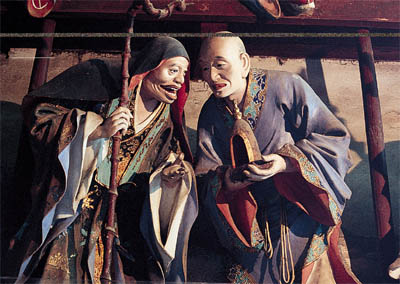
Xiongbian preached Buddhist sutras for 22 years in the temple. In the fourth year (1300) of Dade of the Yuan Dynasty, he passed on his Buddhist legacy to his disciple Xuanjian. In addition, Kublai Khan, the fifth emperor of the Yuan Dynasty honored him with the name “Hongjing”.
Master Xuanjian, a disciple of Master Xiongbian. In the fifth year (1301) of Dade of the Yuan Dynasty, he went to the Capital to meet with Emperor Chengzong and was awarded the Tripitaka Sutra. Then, in the third year (1316) of Yanyou of the Yuan Dynasty, Xuanjian was honored as the “head monk” by Emperor Renzong.
Monk Mengfo. During the period of his management of the Bamboo Temple, the magnificent Five Hundred Arhat Statues were established.
Mingdao (an elder of the temple, 1917-2020). He was the first Buddhist abbot of Chinese Buddhism registered by the State Council since the liberation of Yunnan and was the oldest monk in Yunnan Province. In April 1945, he became a monk in the temple. He has devoted himself to Buddhism and was responsible for the rebuilding of the Huayan Pavilion.
Enter from the gate of the temple →The Hall of Sakyamuni → Huayan Pavilion → Heavenly King Hall → “Tiantailai” Pavilion → Fanyin Pavilion → Exit
Take bus C61, C62 or Shuttle C63 and get off at the Qiongzhu Temple Station.
Chinese: 请带我去筇竹寺。English: Please take me to the Qiongzhu Temple.
If you go to the Qiongzhu Temple from the center of Kunming (Inter-Continental Hotel), it takes about 45 minutes (about 65 yuan).
If you go to the Qiongzhu Temple from Kunming Railway Station, it takes about 50 minutes (about 70 yuan).
If you go to the Qiongzhu Temple from Kunming Changshui International Airport, it takes about 60 minutes (about 120 yuan).
If you go to the Qiongzhu Temple from Kunming South Train Station, it takes about 70 minutes (about 200 yuan).
